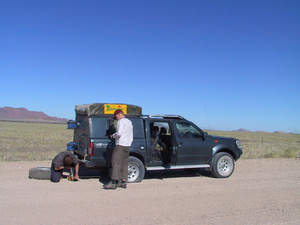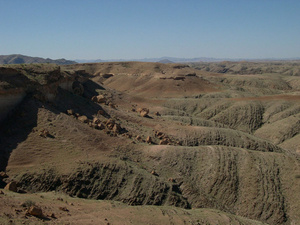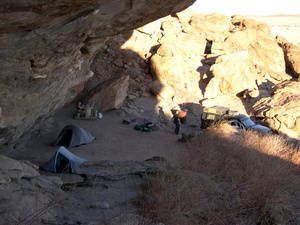Henk Dop: Namibia Trip Report 2005
We turn left again at Büllsport, the C14 through the mountains is now a extremely smooth, thanks to the padskraper (grader) that we meet - amazing how these machines and their lone operators manage to do this. As usual, we honk and wave in appreciation of the work being done. Then, just as we can almost smell the coffee of Solitaire, a rumbling and flapping sound announces that something is seriously amiss with the right rear tyre. I pull over immediately, but the damage has already been done. A large sharp stone has gone right through the tyre, all air must have been lost in a second or so, the rim is too hot to touch and clearly badly damaged. Maarten and I change the wheel in less than 20 minutes, a considerate fellow tourist not only fails to stop and ask if we’re OK, but throws his speeding dust all over us.
We head for Solitaire, fuel up, and I park the car at the workshop. The mechanic points at the damaged rim and the size of the puncture, putting a tube in (the car carries one among the set of spares) might help, but to throw away the tyre would be better. I can only agree, especially in view of our Kaokoland plans. They do have new tyres for sale, and when it turns out that among these is a Bridgestone Dueller AT of the correct size (we had Duellers last year and they performed wonderfully, just loving the deep sand and mud in Botswana), my mind is quickly made up, and a brand new Dueller is put in place.
While this is being done, I join Marike and Maarten for coffee on the porch. I share my misgivings with them on the Yokohama's: I have simply lost faith in these tyres, and especially loosing a rim in what should have been a straightforward puncture, also considering that we had a similar fast puncture on last year's Duellers without losing the rim, hits me rather hard. My crew agrees, they seem to notice quite well that regardless of any merits that the Yokohama's may have, I simply no longer feel good about them. I hint that I'd actually like to replace the other rear tyre as well, and receive their support. 'Do you have another Dueller?' - yes, they do. Fortunately, Solitaire does accept creditcards – the tyres don’t come cheap!
So now the other rear Yokohama is also taken off, as well as the tyre of the spare wheel (an elderly thing with six plugs in it), the Yokohama is put on the spare wheel, whereas the tyre from the spare wheel is strapped to the roof. It takes a bit of work, but by 1100 we're ready to continue with our new pair of Duellers. It feels good, and we make sure that our friendly mechanic gets his share of that feeling.
We now head for the Gaub Pass, amazing how familiar the landscape looks, considering that it has been five years since we last came through here. But then again, few landscapes are so impressive as those in Namibia. We then enter the range of contorted hills to the East of the Kuiseb, bent and folded in every direction, their mica schists glimmering in the noon sun. Work is being carried out on the steep winding road down into and up out of the valley of the Kuiseb - no luxury. After the top of the pass, we turn left and proceed to the lookout point over the Kuiseb, it's starkly eroded landscape and canyons unfolding below us. This is where Henno Martin and his friend Hermann Korn managed to survive for many months out in the desert. Having fled impending war in Germany and moved down to SWA and finding work there, these young geologists also had little appetite for being interned by the South African authorities after the actual outbreak of WWII. So, they moved out into this part of the Namib that they had come to know during their geological explorations.
Martin's book Wenn es Krieg gibt, gehen wir in die Wüste, translated into English as The sheltering desert, is truly a must-read for anyone interested in desert-lore. A path winds down to Martin's camp in this area, named 'Carp's Cliff'. Marike and Maarten walk down the path for a bit, but clearly it goes down quite a long way, longer than we have time for. But at last I get a good look at the landscape that Martin describes, including what he refers to as the 'Gramadoela's', impressive smoothly eroded steep valleys perpendicular to the course of the Kuiseb. No wonder that he found them to be so utterly, if not frighteningly inhospitable.
We continue on the C14 and show Maarten the 'Kries se Rus' campsite where we spent a shivering cold night in 2000 ('Kries se Rus' is usually described as 'the place where a fellow called Kries once had a fine rest', but on a reprint of a 1909 German map that I recently bought, the mountains to the North of Kries se Rus, now called Langer Heinrich Berge, are indicated as 'Kairakarus', probably the original Nama name, which could have easily been bastardised into 'Kries se Rus').
Turning back, we branch of South from the C14 on one of the unnumbered tracks that traverse this section of the Park, and for which a visitor’s permit is required. We go past Beacon Hill, turn right and now enter the most barren portion of this part of the stony Namib North of the Kuiseb. The sparse vegetation becomes even sparser, and we approach today's destination around 1530: Mirabib, a lone and ancient red granite Inselberg, rounded by ages of crust erosion, a relic from the days when the planet was still young. We choose a site on the South side of the Berg, under an overhanging cliff. There's one other set of campers and a caretaker crew, but they are hundreds of meters away, well out of sight and earshot, so we feel as if we have the entire place to ourselves. We set up camp and prepare for a boerewors braai and potato salad, pausing for photo's of the incredible sunset. This is truly a magic place, bats appear from within the rocks, the moon is discreet and doesn't rise until after we've been able to fully enjoy the starlight at its very brightest. After the bats have turned in again, the silence is as silence should be – complete and all-embracing.



